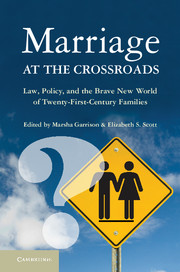Book contents
- Frontmatter
- Contents
- Contributors
- Acknowledgments
- Introduction
- Part I History, Demographics, and Economics – Multiple Perspectives on Families
- Part II Empirical Research on Family Change
- Part III Family Policy and Law for the Twenty-First Century
- Comments
- 14 The Growing Diversity of Two-Parent Families
- 15 Legal Regulation of Twenty-First-Century Families
- Index
- References
14 - The Growing Diversity of Two-Parent Families
Challenges for Family Law
Published online by Cambridge University Press: 05 November 2012
- Frontmatter
- Contents
- Contributors
- Acknowledgments
- Introduction
- Part I History, Demographics, and Economics – Multiple Perspectives on Families
- Part II Empirical Research on Family Change
- Part III Family Policy and Law for the Twenty-First Century
- Comments
- 14 The Growing Diversity of Two-Parent Families
- 15 Legal Regulation of Twenty-First-Century Families
- Index
- References
Summary
One of the most striking characteristics of heterosexual marriage as a social institution today is that it must share its legitimacy with several other types of intimate partnerships, all of which are increasingly accepted as families throughout most of the industrialized world. For instance, acceptance is growing for cohabitation as a respectable alternative to marriage and for same-sex marriage as a respectable alternative to heterosexual marriage. These newer forms of partnership represent substantial changes from the way family life was organized a half-century ago, when heterosexual marriage was dominant. The emergence of these alternatives introduces the issue of whether society will not only recognize them culturally but also support them in law. In particular, it raises the question of how to extend family law to cohabiting couples, same-sex or different-sex, and to same-sex married couples. The answers to this question are surprisingly complex, as the chapters in this volume show.
The acceptance of alternative forms of two-parent families is a relatively new development. Until the middle of the twentieth century, heterosexual marriage was the only socially acceptable, two-parent setting in which to raise children. Cohabitation – living with a partner without marrying – was shameful, except perhaps among the poor and the bohemian. Marriage was predominant in all countries, throughout the class structure, and among all major racial and ethnic groups. Moreover, starting with the rise of “separate spheres” marriage in the nineteenth century, marriage evolved into an institution based on the specialization of men in paid work in the labor market and women in housework and child care. This so-called breadwinner-homemaker marriage peaked in the 1950s, when the postwar prosperity allowed more couples to keep wives out of the labor market.
- Type
- Chapter
- Information
- Marriage at the CrossroadsLaw, Policy, and the Brave New World of Twenty-First-Century Families, pp. 287 - 302Publisher: Cambridge University PressPrint publication year: 2012
References
- 2
- Cited by



